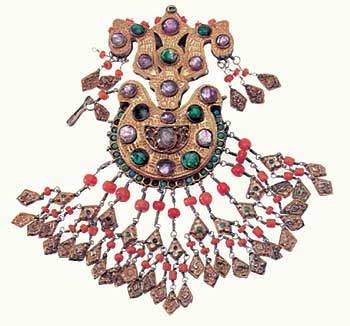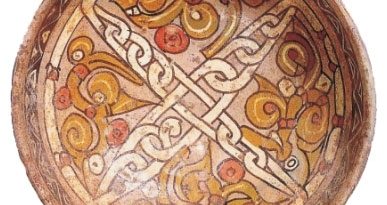The Khorezm Jewelry Art
Among all jewelry art schools having been known in Uzbekistan by the beginning of the 20th century the Khorezm School distinguished for the most expressive and original art canons. Jewelry made by Khorezm jewelers present extraordinary plurality of forms, splendid decorative motives, magnificent and complicated compositions, fine furnish and well-formed details. Typical are incrustations of colourful glass, numerous pendants in a form of chains with beads along, small leaves, burgeons and corns, which symbolize fertility in jewelry art. They bear typical features of exquisite urban art. Like any other school this one was not isolated but developed in a contact and cooperation with other centers. The closest connection can be found, though it may seem strange at a first look, with Turkmen and Karakalpak jewelry art, which reserved traditions of the steppe style.
The last one is characterized with laconic and monumental forms, strict decor and lines. The Khorezm, Turkmen and Karakalpak jewelry are almost identical in their constructive and semantic grounds, but general interpretation of each group of Khorezm jewelry was transformed much under the influence of urban aesthetics, which contributed fractional division and fineness into jewelry art. But basic differences lay in the technology of manufacturing: the Khorezmians used thin sheet silver and gilding, engraving or filigree, wealth of stones – corals and turquoise, cornelian and colourful glass, whereas the Turkmen and Karakalpak things were made of more massive silver sheets and seem a bit heavy; the gilding is extremely rare.
Almost each Khorezm adornment has its analogue in the group of the Turkmen silver jewelry. Thus, the Khorezm taq’ya duzi – adornment for a cap – is the analogue of the Turkmen tah’ya. Semantics of this jewelry in a shape of round, quadrangular, hexagonal and octagonal plate or small dome, from which numerous pendants fall down, goes back to helmets of women-warriors, “Amazons”. At the same time, if the Turkmen version reserved the most archaic form, close to a helmet, in the case of the Khorezm School it stands far from its prototype at the result of decorative re-interpretation. It resulted in the occurrence of polygonal plates, which contain no reminding of a helmet.
Another type of adornments is connected with legendary Amazons – uk-ei (bow and arrow) – head adornment, which was fastened on the cap-tah’ya. Its form is typical both for the Khorezmians and the Turkmens. This is a composite adornment having a bow with tight string in its basis and numerous drops-arrows. Prototype of this form seems obvious – a bow was the integral part of nomadic way of life including female members of tribes. Unlikely its prototype can be found in the neck-flap of a cap and helmet, as D. Fahreddinova supposed (1, p. 125). Probably, location of adornment on a back side of the head was connected with the manner to carry a bow on a back and therefore the symbolism of adornment lays in the protecting function of the back, or rear. Its direct analogue is the Turkmen adornment ok-yai (bow and arrow), which also was worn on the back and sewed on the clothes. Turkmen variant of the adornment is rather massive, up to 15 – 17 cm in length, it has austere and laconic form that is the same features, which in general are typical for jewelry of the Turkmen jewelers and which are decorated just with some encrusted stones. Arrow-drops are not numerous and have simpler form. In its own turn, Khorezm uk-ei is decorated with rich filigree of complicated pattern, myriad gems and chains with stamped pendants. They also reveal the trend towards conventional decor, when a form of adornment just slightly reminds of its prototype. Thus, stylistic alterity of adornments is considerable, but their structure, composition and genesis are common.
The Khorezm temple-ear drop yarim-tirnok presents the analogue of Turkmen dagdans. D. Fahreddinova, investigating this massive double-part jewelry, decorated richly with gems and cascade of pendants, considers that the shape of its upper part is formed by means of ternary composition going back to trident. This composition embodies a portrayal of Goddess – Mother with figurines of horses in front. At the same time, a form of the low part is related to the adornment bibishok that reminds of two birds looking to and fro. German scholar Y. Kalter associated the upper part of the adornment with styled double-head royal eagle. But all these interpretations cause reasonable doubts. The direct analogue of this shape is the Turkmen pectorals – dagdans in a form of scarabs and frogs, semantic of which is connected with fertility. Frog was among totem animals of nomadic tribes. The upper part of adornment, in which D. Fahreddinova found a portrayal of a goddess with horses, is nothing less than frog’s head and front feet. Manglai-tuzi or osma-tuzi is a frontal adornment, consisting of figured plates put together with hinge joints and decorated with gems. Each plate is decorated with stamps, encrustation and gilding. Analogous adornments are known in Bukhara, Samarkand and Tashkent under the name tilla bargaq (golden leaves). D. Fahreddinova connects semantics of the Khorezm variant with re-interpretation of human bodies standing in a row and finds their analogues in the Buddhist paintings of Fayaz-tepa where a deity is located beside the figurines of sitting and standing saints.
But the form of this adornment can cause another idea: it is a symbolic picture of fortress walls. Generally, the connection of head adornments and architecture was revealed in traditions of many peoples (Russian kokoshnik, crowns in a form of domes). Turkmen variant of this adornment is mangailik. Thus, it cannot fail to be seen that major Khorezm artifacts go back to traditions of the steppe culture and have indissoluble genesis with Turkmen jewelry. Such integrity in forms leads us to the historical period when Uzbek, Turkmen and Karakalpak tribes in Khorezm survived through the process of formation, it means in the time of the Oguz having played important role in the ethnogenesis of these peoples (the 10th c.). Definite ethnic and historical homogeny became a ground for the appearance of similar motives and forms in art. But development of forms in jewelry followed different course. If in the case of Khorezm, we can see products of advanced urban civilization, where refined cultural traditions caused intense decorating of steppe jewelry forms, but Karakalpak and Turkmen jewelers, except those who lived in towns, continued to follow ancient steppe traditions, so reserving the most archaic forms. What is interesting that we found original differentiation in the case of the Turkmen tribes. Thus, the Ersari and the Yomuds, which were very far from sedentary life, the jewelry also are getting close to the style of “silver bullion”, whereas the Tekin jewelry are massive and laconic in a form.
Refined urban aesthetics influenced on the jewelry of the Khorezm urbanized Karakalpaks and Turkmens. They demonstrated notable style transformation of traditional adornments towards more decorative features. The forms going back to the art of nomadic steppe (amulets-dagdans in a form of frog sewed on caps and heart – shaped amulets – asiks) are richly incrusted with colourful glass, numerous pendants with corals. Thus, in a course of comparison of asiks manufactured by nomadic and Khorezm sedentary Turkmens, the differences can be easily noticed. The Khorezm variant is decorated with niello, which is not traditional for the Turkmens; decor in a style of islimi is getting more fractional and atomized. Generally asik much more reminds of heart-shaped pendant, where is cross-shaped motif (chahar-chirag), being in carpets, embroidery and ceramics, instead of incrustation with cornelian (a symbol of seed, rising new life).
We should mention transformation of amulet-containers – tumars. Tumars (mainly pectorals) were very popular among the Uzbeks, Tadjiks, Uygurs, Karakalpaks and others. They were special cases of various forms (triangular, round, rectangular, cylindrical), which were used as containers for amulets. Classic form is presented by hollow cylinder in horizontal position with triangular plate soldered on (trigon is a classical symbol relating to magic protection against whammy) and decorative drops in its lower part. Usually the role of amulet belonged to a sheet of paper with a text of some prayer. Tumar with amulet inside guaranteed welfare to its owner. Probably, tumars came to the nomads with Islam. The Khorezm jewelers use a form of tumar but superfluity of filigree and pendants, corals and turquoise gives to them too decorative image. Sometimes a case, as it is, disappears and tumar transforms in a flat adornment, and its magic and ritual function is getting loose its meaning.
Y. Kalter considers that it’s possible to say with good reasons about influence of northern India or Nepal on the jewelry of this region: “All the evidences go to prove that already in the 19th century the trade contacts were between Khiva, the ancient capital of Khorezm and India, though.” – he added. – “the sources contain no information about real connection of Khorezm jewelry style with Northern-Indian and Nepal centers.”. These conclusions have no reasonable ground: major forms of Khorezm jewelry find their parallels within local region, and their “steppe” genesis causes no doubts. Even intensive trade between cities of the Khiva khanate and Iran (import of carpets and jewelry) remained almost no traces in the Khorezm jewelry art and did not cause any syncretic forms. Nevertheless, foreign influence obviously had place in the development of the Khorezm jewelry art and, first of all, it was connected with appearance of enamel. As D. Fahreddinova noted, in the 19th century the enamel technology got its active development in art of Azerbaijani jewelers, which “from time to time arrived to Khorezm for a work”. Jewelers from Baku manufactured especially splendid adornments covered with enamel. They used different technologies – stamp, filigree, carving and others, whereupon different types of enamel working became widespread – cell enamel, cut enamel and enamel-painting. Central Asian jewelers, especially from Bukhara, knew this technique but could not reach perfect results. Frontal parts of traditional Khorezm set “shikila” are not rare. They were decorated with painted enamel. A form of basic element of the adornment is bodom (buta) that also reminds us of traditions of Azerbaijani art, where this motif was extremely popular.
Obviously, analysis of Khorezm jewelry forms is not limited within examples we mentioned here and can be extended. In any case it is definitely that searching of analogues opens the opportunity not just to reveal the original roots of this or those form but to clear the science in regard to ethno-genetic connections between peoples.
Author: Elmira Gyul




I am really enjoying the theme/design of your website. Do you ever run into any web browser compatibility issues? A couple of my blog visitors have complained about my site not working correctly in Explorer but looks great in Chrome. Do you have any ideas to help fix this issue?